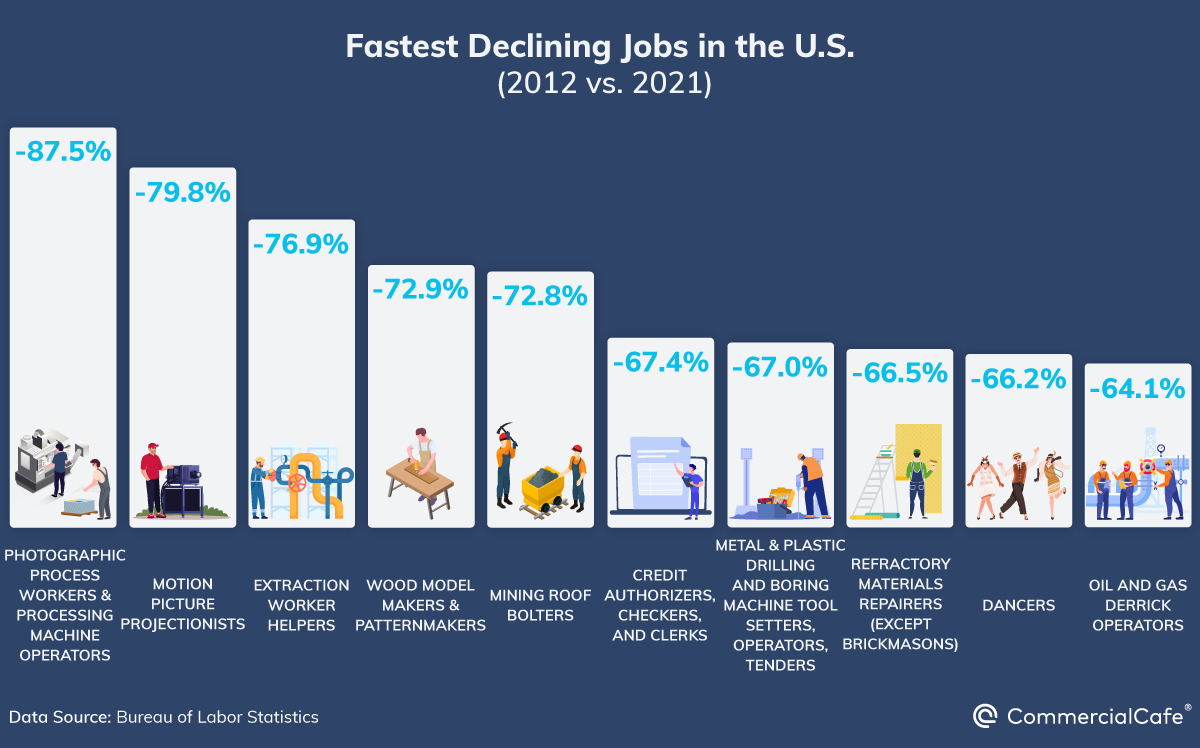As we wrap a second year of highly dynamic shifts in the post-COVID economy landscape, we’ve been looking into job trends. First, we focused on the fastest-growing jobs in the U.S. and found that the healthcare and green energy industries accounted for some of the most thriving occupations of the last decade. We also wanted to take a look at the opposite end of the spectrum: Which occupations have seen the sharpest decline during that same time?
Using data from the Bureau of Labor Statistics’ (BLS) Occupational Employment Statistics, we looked at occupational decline from 2012 through 2021 (see the methodology section below for details). Below are our findings on the 10 fastest-shrinking jobs in the U.S.; the steepest job drop in each of the states we analyzed; and what may have influenced their downward trajectories.
Photographic Processing & Movie Projection Hit Hardest
Of course, various jobs across the entertainment industry have been undeniably affected by the COVID-19 pandemic. That said, it’s safe to assume that digital technology integration has had a more notable contribution to the decline in some of these occupations across the decade we surveyed. For instance, our analysis found three entertainment- and arts-related activities among the 10 fastest-declining jobs in the U.S. Notably, the two that landed at the top of the list were most likely victims of rapid technological advances that drove changes in their respective industries.
Specifically, jobs for photographic process workers and processing machine operators recorded a nearly 88% drop. As a result, they stood out as the fastest-dwindling occupations in the country during the last decade: In 2012, BLS data showed that nearly 46,000 jobs were filled in this line of work. But, by 2021, that number had diminished to a little more than 5,700.
While it’s easy (and somewhat reasonable) to point the finger at automation, the drop in job numbers for this profession could be the result of a combination of multiple converging trends. For example, contributing causes might include: an increase in consumer preference for the digital imaging medium, rather than physical prints; fine-tuned, camera-equipped mobile devices that are now more readily accessible; and increased accessibility of complex image processing possibilities for non-professionals.
The second-fastest decline was seen in the nearly 80% drop in motion picture projectionist jobs, which shrank from a little more than 8,000 in 2012 to roughly 1,600 last year. As motion picture technology advanced and the movie-going experience became increasingly experiential, the movie theatre business — itself now largely made up of standardized chain multiplex theatres — grew apart from the highly experienced projection specialists who used to man the country’s multitude of movie screens.
The third entertainment-related category that landed in this top 10 was professional dancers. With a 10-year decline of a little more than 66%, it landed ninth among the fastest-declining occupations of the decade. In this case, 2012 data showed that there were nearly 11,000 workers employed in this profession, whereas there were less than 3,900 on record in 2021.
Jobs in Extraction & Construction Activities Shed Hefty Numbers
The third-fastest-declining job in the country during the last decade was the extraction work helper. Numbers in this profession dropped nearly 77%, from 25,840 workers in 2012 to just below 6,000 in 2021 — a decrease of nearly 20,000 jobs that previously filled in this occupation.
Meanwhile, mining roof bolters accounted for the fifth-fastest-declining job in the country. The number of jobs in this labor-intensive and particularly perilous profession dropped nearly 73% during the decade we surveyed, going from just below 6,800 workers in 2012 to barely 1,500 in 2021.
Likewise, employment opportunities for metal and plastic drilling and boring machine workers shrank 67% in 10 years, from more than 20,600 jobs in 2012 to about 6,800 jobs last year — the seventh-steepest job decline of the decade. And, while concerted efforts to re-shore manufacturing may lead to an uptick in demand for manual machine tool operators and tenders in the coming years, growth prospects for this job remain limited in the long term. Unsurprisingly, this is mostly due to the continued advancement and adoption of labor-saving machinery across a growing number of traditionally labor-intensive industries.
Finally, the 64% decrease in oil and gas derrick operator jobs rounded out the list of the 10 fastest-declining professions in the U.S. Granted, the great slowdown in consumption at the start of the COVID-19 pandemic led fossil fuel companies to drop or furlough several jobs directly involved in extraction activities. However, the number of derrick operator jobs in the industry had been steadily declining throughout the decade between 2012 and 2021, from just below 22,000 workers to nearly 7,900.
Manufacturing, Maintenance & Handling Jobs Take the Largest Loss in 22 States
Photographic process workers and processing machine operators were the fastest-declining professions in 10 states: Virginia (-96%); Arizona, Ohio, and South Carolina (-95%); Texas (-94%); Maryland (-93%); New Jersey (-92%); Washington and New York (-90%); and New Hampshire (-82%).
At the same time, while engine and machine assembly jobs quadrupled in Indiana, the number of boilermakers here dropped 90% in 10 years, going from a little more than 3,000 workers in 2012 to just 300 in 2021. Unfortunately, this is not surprising, as the process of making boilers has been largely automated throughout the years. Plus, as new technologies are developed away from gas- and electricity-fueled heating systems, boilers themselves may become obsolete over time. Even so, boilermakers remain relevant to the industry: This is a product with an expected life of several decades and, as such, it still requires professional maintenance and retrofitting to prolong its useful life. Subsequently, skills gained in this profession can be relevant to the manufacturing and maintenance of whatever technology is likely to replace boilers (such as heat pump systems).
Additionally, the Delaware economy shed 92% of machinery maintenance worker jobs in the last decade. Similarly, the number of tailors, dressmakers, and custom sewers in Alabama dropped 92%, dwindling from nearly 500 in 2012 to just 40 last year. Further west, earth drillers (except oil and gas) were the sharpest-declining jobs in Oklahoma, where numbers fell 94% in 10 years, as well as in Wyoming, where jobs in this profession dropped by 88%. Meanwhile, in Nebraska, the number of workers on record as paper goods machine setters, operators, and tenders fell 86% from 2012 through 2021.
13 States Saw Sharpest Declines in Business or Service Jobs
As far as the business- or service-related professions that stood out as the fastest-declining, telemarketers saw the greatest drop in terms of percentage in four states: In Kansas and in South Dakota, jobs in this profession fell 95%; in Mississippi, they dropped by 92%; and, in West Virginia, the decline rate was 91%.
At the same time, credit authorizers, checkers, and clerks marked the sixth-fastest-declining job nationwide, with a decrease of more than 67% — from 51,650 workers in 2012 to roughly 16,800 in 2021. Plus, in Connecticut, it topped the list of most rapidly shrinking jobs of the decade, recording a drop of 96%.
In Illinois, desktop publisher jobs fell 92%, going from 890 in 2012 to just 70 last year. During that same time, the number of word processor and typist workers in Minnesota also fell 92%, from 1,070 to 90. And, the largest decline rate in Vermont was 85% for mail clerks and mail machine operators (outside of the Postal Service).
Check the table included below for more details on the fastest declining jobs in each of the states we analyzed:
Methodology
We used data on Occupational Employment Statistics that was reported by the Bureau of Labor Statistics from 2012 to 2021. Specifically, we looked at job decline in terms of the percentage decrease from 2012 through 2021 in the total number of employees within an occupational category. Due to lack of details, we excluded all occupations with a suffix of “all other” or “miscellaneous.”
Our analysis included data on the 48 states included in what is defined as “the contiguous continental United States.” The District of Columbia and Alaska, as well as Hawaii and other offshore, insular areas (such as American Samoa, Guam, the Northern Mariana Islands, Puerto Rico and the U.S. Virgin Islands), were not considered for this analysis.










